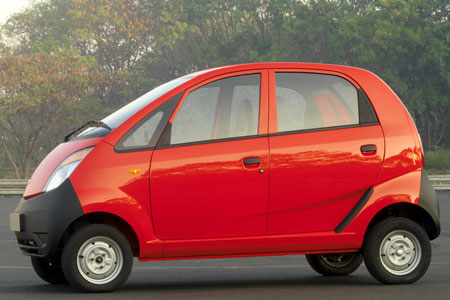The Tata Nano is an inexpensive, rear-engined, four-passenger city car built by the Indian company Tata Motors and is aimed primarily at the Indian domestic market.
Tata Motors began selling its "one-lakh car" in March, 2009. The cheapest car in the world today,[ though the price continues to rise due to increasing material costs, it is an exemplary example of Gandhian engineering, a concept involving deep frugality and a willingness to challenge conventional wisdom.
In 2008 the Financial Times reported: "if ever there were a symbol of India’s ambitions to become a modern nation, it would surely be the Nano, the tiny car with the even tinier price-tag. A triumph of homegrown engineering, the $2,200 (€1,490, £1,186) Nano encapsulates the dream of millions of Indians groping for a shot at urban prosperity." "Homegrown engineering" is a relative term here as much of the systems and parts used in the Nano may not have been developed or produced in India.
The nickname, "one-lakh car" is due to the Nano's low price point, near 100,000 (one lakh rupees).
Seeing an opportunity in the great number of Indian families with two-wheeled rather than four-wheeled vehicles, Tata Motors began development of an affordable car in 2003. The purchase price of this no frills auto was brought down by dispensing with most nonessential features, reducing the amount of steel used in its construction, and relying on low-cost Indian labor.
The introduction of the Nano received much media attention due to its low price.
While the car has sold over 200K units, disappointing November, 2010, sales figures have made some rethink current opinion that selling no frills products to the poor will be a winning strategy in the future.
The Nano's development was foreshadowed by the 2005 success of the affordable, 4-wheeled Tata Ace truck.



Tata Motors began selling its "one-lakh car" in March, 2009. The cheapest car in the world today,[ though the price continues to rise due to increasing material costs, it is an exemplary example of Gandhian engineering, a concept involving deep frugality and a willingness to challenge conventional wisdom.
In 2008 the Financial Times reported: "if ever there were a symbol of India’s ambitions to become a modern nation, it would surely be the Nano, the tiny car with the even tinier price-tag. A triumph of homegrown engineering, the $2,200 (€1,490, £1,186) Nano encapsulates the dream of millions of Indians groping for a shot at urban prosperity." "Homegrown engineering" is a relative term here as much of the systems and parts used in the Nano may not have been developed or produced in India.
The nickname, "one-lakh car" is due to the Nano's low price point, near 100,000 (one lakh rupees).
Seeing an opportunity in the great number of Indian families with two-wheeled rather than four-wheeled vehicles, Tata Motors began development of an affordable car in 2003. The purchase price of this no frills auto was brought down by dispensing with most nonessential features, reducing the amount of steel used in its construction, and relying on low-cost Indian labor.
The introduction of the Nano received much media attention due to its low price.
While the car has sold over 200K units, disappointing November, 2010, sales figures have made some rethink current opinion that selling no frills products to the poor will be a winning strategy in the future.
The Nano's development was foreshadowed by the 2005 success of the affordable, 4-wheeled Tata Ace truck.


